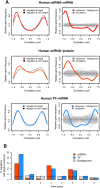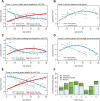MicroRNA, mRNA, and protein expression link development and aging in human and macaque brain
- PMID: 20647238
- PMCID: PMC2928499
- DOI: 10.1101/gr.106849.110
MicroRNA, mRNA, and protein expression link development and aging in human and macaque brain
Abstract
Changes in gene expression levels determine differentiation of tissues involved in development and are associated with functional decline in aging. Although development is tightly regulated, the transition between development and aging, as well as regulation of post-developmental changes, are not well understood. Here, we measured messenger RNA (mRNA), microRNA (miRNA), and protein expression in the prefrontal cortex of humans and rhesus macaques over the species' life spans. We find that few gene expression changes are unique to aging. Instead, the vast majority of miRNA and gene expression changes that occur in aging represent reversals or extensions of developmental patterns. Surprisingly, many gene expression changes previously attributed to aging, such as down-regulation of neural genes, initiate in early childhood. Our results indicate that miRNA and transcription factors regulate not only developmental but also post-developmental expression changes, with a number of regulatory processes continuing throughout the entire life span. Differential evolutionary conservation of the corresponding genomic regions implies that these regulatory processes, although beneficial in development, might be detrimental in aging. These results suggest a direct link between developmental regulation and expression changes taking place in aging.
Figures







Similar articles
-
Transcript and protein expression decoupling reveals RNA binding proteins and miRNAs as potential modulators of human aging.Genome Biol. 2015 Feb 22;16(1):41. doi: 10.1186/s13059-015-0608-2. Genome Biol. 2015. PMID: 25853883 Free PMC article.
-
MicroRNA-driven developmental remodeling in the brain distinguishes humans from other primates.PLoS Biol. 2011 Dec;9(12):e1001214. doi: 10.1371/journal.pbio.1001214. Epub 2011 Dec 6. PLoS Biol. 2011. PMID: 22162950 Free PMC article.
-
MicroRNA expression and regulation in human, chimpanzee, and macaque brains.PLoS Genet. 2011 Oct;7(10):e1002327. doi: 10.1371/journal.pgen.1002327. Epub 2011 Oct 13. PLoS Genet. 2011. PMID: 22022286 Free PMC article.
-
Messenger RNA decay during aging and development.Ageing Res Rev. 2002 Sep;1(4):607-25. doi: 10.1016/s1568-1637(02)00023-5. Ageing Res Rev. 2002. PMID: 12208236 Review.
-
Genomic organization of microRNAs.J Cell Physiol. 2010 Mar;222(3):540-5. doi: 10.1002/jcp.21993. J Cell Physiol. 2010. PMID: 20020507 Free PMC article. Review.
Cited by
-
Upregulation of a small vault RNA (svtRNA2-1a) is an early event in Parkinson disease and induces neuronal dysfunction.RNA Biol. 2013 Jul;10(7):1093-106. doi: 10.4161/rna.24813. Epub 2013 May 1. RNA Biol. 2013. PMID: 23673382 Free PMC article.
-
MiR-29 coordinates age-dependent plasticity brakes in the adult visual cortex.EMBO Rep. 2020 Nov 5;21(11):e50431. doi: 10.15252/embr.202050431. Epub 2020 Oct 7. EMBO Rep. 2020. PMID: 33026181 Free PMC article.
-
The temporal expression patterns of brain transcriptome during chicken development and ageing.BMC Genomics. 2018 Dec 13;19(1):917. doi: 10.1186/s12864-018-5301-x. BMC Genomics. 2018. PMID: 30545297 Free PMC article.
-
Loxl2 is a mediator of cardiac aging in Drosophila melanogaster, genetically examining the role of aging clock genes.G3 (Bethesda). 2022 Jan 4;12(1):jkab381. doi: 10.1093/g3journal/jkab381. G3 (Bethesda). 2022. PMID: 34734976 Free PMC article.
-
A role for noncanonical microRNAs in the mammalian brain revealed by phenotypic differences in Dgcr8 versus Dicer1 knockouts and small RNA sequencing.RNA. 2011 Aug;17(8):1489-501. doi: 10.1261/rna.2442211. Epub 2011 Jun 28. RNA. 2011. PMID: 21712401 Free PMC article.
References
-
- Boehm M, Slack F 2005. A developmental timing microRNA and its target regulate life span in C. elegans. Science 310: 1954–1957 - PubMed
-
- Cahoy JD, Emery B, Kaushal A, Foo LC, Zamanian JL, Christopherson KS, Xing Y, Lubischer JL, Krieg PA, Krupenko SA, et al. 2008. A transcriptome database for astrocytes, neurons, and oligodendrocytes: A new resource for understanding brain development and function. J Neurosci 28: 264–278 - PMC - PubMed
MeSH terms
Substances
Associated data
- Actions
LinkOut - more resources
Full Text Sources
Other Literature Sources
Medical
Molecular Biology Databases
